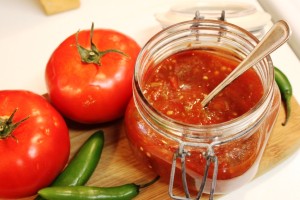

- 15 lbs slightly under-ripe tomatoes (~35 medium)
- 20 assorted large hot peppers
- 4 - 8 jalapeno peppers
- 2 large green peppers
- 2 or 3 large onions
- 13 oz tomato paste
- 3 12 oz beer
- 2 cups vinegar
- 2 Tbsp sugar
- You're going to skin the tomatoes by blanching. Get 2 or 3 litres of water boiling in a wide pot and fill a clean sink with 4-5 litres cold water. Select about 30 barely ripe and 5 definitely under-ripe tomatoes. Drop tomatoes in boiling water for 40-60 seconds (NO MORE) in batches of 6 or less. Quickly fish them out and drop in the cold water. Theoretically the skins should peel off with minimal effort. Cut out big stem ends and cut into 1/8ths or whatever to make 1 to 2 cubic inch volume pieces. Slightly larger is OK, smaller is no good. Throw pieces in plastic bowl or pail and mix in 1/2 cup pickling salt. You should have at least 8 litres. cover and let sit for 3 to 12 hours. the salt will suck most of the water out of the tomatoes and if you don't screw around and shake things up, you'll be pouring off 2-3 litres of clear, salt water.
- Carefully drain tomatoes. the more salt water you lose the better. throw tomatoes, vinegar and sugar in the soup pot and start heating at medium. Place saucer or small bowl in freezer. Meanwhile, your assistant has been chopping all the hot peppers and 4 of the jalapenos in the processor. Use everything except stems, chop very fine and throw in with the tomatoes as soon as possible. Time to crack beer #1 because now your pinned there gently stirring for the next hour as the salsa starts to simmer. Assistant should enjoy beverage of preference in moderation as dangerous utensils are in use. The salsa will burn if you don't stir it. Keep it at a gentle simmer. check the time and remember when simmering started. Do not taste. Meanwhile your assistant is manually chopping the onions and green peppers in 1/2 to 1 inch pieces. Remove green pepper seeds. At precisely 30 minutes past start of simmer throw in the onions, green peppers and the tomato paste. Fill canner with hot water, jars and lids and get it boiling. At precisely 45 minutes past start of simmer, spoon 3-6 tablespoons of salsa into bowl from freezer and return to freezer. Avoid tasting the hot salsa. At 50 mpsos (figure it out) cleanse palate with ice cold beer #2 and ready nacho chips. At 55 mpsos remove cooled salsa from freezer. It must be at room temperature or lower. Taste. If mild, quickly add 3 or 4 more jalapenos and cook for 10 more minutes. If too hot, too bad girlie-man.
- Remove salsa from heat and stir often as you deftly fill your sterilized jars to precisely 1/2 inch from the top. Wipe rims, install lids and screw on rings snug but not tight. Place jars in the canner and ensure there is 1 inch of water covering tops of jars. Process at full rolling boil 20 minutes (plus 10 minutes to adjust for altitude of Calgary). Enjoy beer #3 while monitoring processing and supervising Phase 4.
- You need about 1 hour, 3 to 12 hours ahead of time to prepare the tomatoes (Phase 1). The salsa (Phase 2) and canning (Phase 3) take about 2 hours total. Add 1/2 hour for cleanup (Phase 4).
- Over the years I have tried several additional flavourings such as fresh coriander, minced garlic and even added a couple of peaches for a bit of sweetness. All have been delicious. Have fun and experiment with your own ideas.
You’ve probably heard a million times that you should buy locally grown. And, you’ve also probably seen local farmers markets popping up all across the city. But why should you buy local? What’s the benefit to you, your community and the environment? Most of the food we consume is not only being transported long distances to our plates but what goes into our food and who actually produces it is often hidden from us. Eating locally can be beneficial to both the environment and your health, and in putting your dollars into supporting the local community and farmers directly.
A great way to start making more sustainable food choices is by making changes to our diet and eating habits. Here’s some ways you can adopt seasonal, sustainable food choices to celebrate Earth Day this year or any other day of the year.
Prepare a meal using at least one in-season or local ingredient. Join the local food movement – help your community build a self-reliant, sustainable food economy. Some of the top benefits of buying local ingredients include enhanced taste, nutrients, community and environment. Travelling shorter distances means food is fresher and more nutritious. It also reduces fuel use and carbon emissions required to transport and preserve foods. When you know where your food comes from and the people who produced it, you feel a greater sense of awareness and community.
Visit a restaurant that specializes in locally sourced or organic ingredients. If you are going to eat out, pick a restaurant that sources local or organic ingredients for their dishes. The benefits of eating at locally sourced restaurants are similar to cooking with in-season or local ingredients at home. The added benefit of organic ingredients is that their production methods limit synthetic pesticides and chemical additives, which have negative health implications. Organic food production also uses agricultural practices that prioritize protecting the environment by minimizing soil degradation, maintaining diversity and recycling resources when possible.
Incorporate leftover food into the next day’s meal to avoid unnecessary waste. Canadians are among the world’s most well-fed people, lucky to have access to an abundance and wide variety of food. However, we throw away more than half of our food as “unwanted leftovers” – food that is still edible. To reduce waste, make enough food so that there are sufficient leftovers for another full meal, or be creative and find other dishes that you can make with what you have left. For example, blackened bananas are perfect for banana bread, and stale bread makes good bread crumbs or bread pudding. Look up other fun recipes – leftovers can taste just as good, if not better than the original meal!
Purchase sustainable seafood. Fish and seafood is not only a source of food and nutrition for billions of people – it is also a source of income for many. Overfishing has many serious social, environmental and economic implications. Eating less meat also uses fewer resources, such as water and feed for livestock.
Adapted from http://makeitcount.earthday.ca/eat.php
]]>
